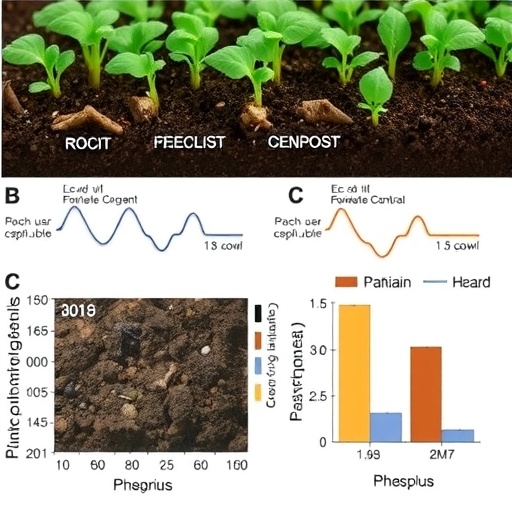The survival of food-borne pathogens, particularly in soil environments, presents a significant challenge to food safety and public health. A recent study sheds light on the persistence of the notorious food-borne pathogen, Escherichia coli O157:H7, across a variety of natural soils in eastern China. Conducted through meticulous inoculation experiments on a diverse array of 81 soil samples, this comprehensive research seeks to unravel the complexities of E. coli O157:H7 survival patterns, providing insights pivotal for safeguarding agricultural practices and mitigating disease outbreaks.
Inoculation studies revealed a striking variance in E. coli O157:H7 survival, with results indicating that the pathogen’s lifespan in soil spans an alarming range from 2.0 days to as prolonged as 43.3 days. This wide discrepancy highlights the significant influence of geographical and environmental factors on pathogen resilience, making the understanding of its survival in soil a pressing concern for both researchers and public health officials alike. The impressive variety of soil types examined provides a foundation for a more nuanced understanding of how different regions may experience varying risks associated with contamination from this bacterium.
The research yielded an informative survival-time map that visualized the hotspots of E. coli O157:H7 survival across the eastern Chinese landscape. This geographical heterogeneity emphasizes the need for localized studies and interventions aimed at controlling pathogen spread. Mapping the regions where E. coli O157:H7 thrives not only offers critical understanding for epidemiologists but also equips agricultural stakeholders with the necessary information to tailor their practices according to the specific risks associated with their local soil conditions.
A bioinformatics analysis conducted as part of the study dug deeper into the underlying causes of the pathogen’s survival variance. It pinpointed available phosphorus as a primary factor influencing E. coli O157:H7 longevity in soil. Soils rich in available phosphorus demonstrated a notable extension in the pathogen’s survival time. This finding underscores the importance of nutrient management within agricultural practices, as insufficient phosphorus levels could inadvertently exacerbate the risk of prolonged pathogen presence in soil, thereby heightening the chances of food-borne illness outbreaks.
Furthermore, the study uncovered intriguing interactions between E. coli O157:H7 and specific opportunistic pathogens prevalent in the studied soils. Two of these were identified as Enterococcus faecium and Aerococcus viridans, both of which play pivotal roles in enhancing the survival of E. coli O157:H7. Enterococcus faecium facilitates the establishment of biofilm structures that provide a protective microenvironment for E. coli O157:H7, allowing it to endure longer in the soil. On the other hand, Aerococcus viridans contributes to the survival of E. coli through a phenomenon known as cross-feeding—sharing metabolic resources that bolster the resilience of the pathogen.
Interestingly, while climate factors were initially considered influential in pathogen survival, the study’s findings suggested that their impact is mostly indirect. This revelation shifts the focus from climate as a straightforward determinant to a more intricate interplay of factors, including soil composition and microbial interactions, indicating that environmental management should prioritize understanding these relationships over merely addressing climatic impacts.
The implications of these findings are profound. By enhancing our comprehension of the mechanisms that underpin pathogen survival, we can foster agricultural strategies aimed at reducing the risks of food-borne illness outbreaks. Implementing practices such as optimized fertilization regimes to maintain phosphorus levels, alongside careful microbial management to control opportunistic pathogens, could significantly mitigate the presence and persistence of E. coli O157:H7 in soils.
Moreover, the research serves as a call to action for lawmakers, agricultural organizations, and public health officials. By staying informed about these survival dynamics, enhanced regulatory measures can be established to ensure that food safety standards are upheld, thus protecting consumers and promoting public health. Understanding how to control pathogen survival in soils could also lead to improved agricultural yield and sustainability, ultimately benefiting farmers and the food industry at large.
The necessity of interdisciplinary collaboration in addressing these challenges cannot be overstated. Ecologists, microbiologists, agricultural scientists, and public health experts must unite to forge comprehensive strategies that can combat the risks posed by food-borne pathogens in soil. This multifaceted approach not only stands to bolster public health safeguards but also to enlighten agricultural practices towards those that inherently decrease the prevalence of dangerous pathogens.
As researchers continue to explore the intricate web of interactions between soil microbiomes and food-borne pathogens, findings like those presented in this influential study hold great promise for advancing our understanding and improving our management of food safety. Future research must continue to combat gaps in our knowledge, particularly regarding regional variations in pathogen behavior and survival in relation to diverse agricultural practices.
In conclusion, the survival of Escherichia coli O157:H7 in soils across eastern China highlights a critical intersection of microbial ecology and public health. As we strive to enhance agricultural practices and minimize food safety risks, harnessing the power of scientific research to inform policies and practices will be essential in ensuring a healthier future with reduced incidences of food-borne illnesses. By understanding and addressing the core issues surrounding pathogen survival, we pave the way for effective interventions that can protect communities and maintain the integrity of our food systems.
Subject of Research: Survival of Escherichia coli O157:H7 in soils across eastern China.
Article Title: Available phosphorus and opportunistic pathogens drive geographic variation in Escherichia coli O157:H7 survival in soils across eastern China.
Article References:
Xu, J., Zhang, N., Yao, Z. et al. Available phosphorus and opportunistic pathogens drive geographic variation in Escherichia coli O157:H7 survival in soils across eastern China.
Nat Food 6, 777–786 (2025). https://doi.org/10.1038/s43016-025-01191-2
Image Credits: AI Generated
DOI: https://doi.org/10.1038/s43016-025-01191-2
Keywords: Escherichia coli O157:H7, soil microbiome, food safety, pathogen survival, available phosphorus, opportunistic pathogens, disease outbreaks, agricultural practices, ecological interactions.
Tags: agricultural practices and disease outbreaksE. coli O157:H7 survival in soilE. coli survival patterns in natural soilseastern China soil studyenvironmental factors affecting pathogen resiliencefood-borne pathogens in agriculturegeographic variability in pathogen persistencepathogen lifespan in diverse soil typesphosphorus influence on pathogen survivalpublic health and food safetysoil contamination riskssoil inoculation experiments




